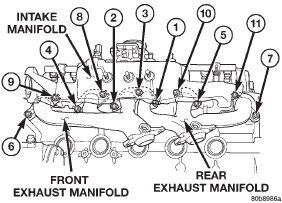Jeep Cherokee (XJ): Intake and exhaust manifold
REMOVAL
NOTE: THE ENGINE INTAKE AND EXHAUST MANIFOLD MUST BE REMOVED AND INSTALLED TOGETHER. THE MANIFOLDS USE A COMMON GASKET AT THE CYLINDER HEAD.
(1) Disconnect the battery negative cable.
(2) Remove air cleaner inlet hose from the resonator assembly.
(3) Remove the air cleaner assembly.
(4) Remove the throttle cable, vehicle speed control cable (if equipped) and the transmission line pressure cable.
(5) Disconnect the following electrical connections and secure their harness out of the way:
- Throttle Position Sensor
- Idle Air Control Motor
- Coolant Temperature Sensor (at thermostat housing)
- Intake Air Temperature Sensor
- Oxygen Sensor
- Crank Position Sensor
- Six (6) Fuel Injector Connectors
- Manifold Absolute Pressure (MAP) Sensor.
(6) Disconnect HVAC, and Brake Booster vacuum supply hoses at the intake manifold.
(7) Perform the fuel pressure release procedure.
(Refer to Group 14, Fuel Systems for correct procedure) (8) Disconnect and remove the fuel system supply line from the fuel rail assembly. (Refer to Group 14, Quick Connect Fittings for correct procedures) (9) Remove the accessory drive belt (refer to Group 7, Cooling System). Loosen the tensioner.
(10) Remove the power steering pump from the intake manifold and set aside.
(11) Raise the vehicle.
(12) Disconnect the exhaust pipes from the engine exhaust manifolds.
(13) Lower the vehicle.
(14) Remove the intake manifold and engine exhaust manifolds.
INSTALLATION
If the manifold is being replaced, ensure all the fitting, etc. are transferred to the replacement manifold.
(1) Install a new engine exhaust/intake manifold gasket over the alignment dowels on the cylinder head.
(2) Position the engine exhaust manifolds to the cylinder head. Install fastener Number 3 and finger tighten at this time (Fig. 50).
(3) Install intake manifold on the cylinder head dowels.
(4) Install washer and fastener Numbers 1, 2, 4, 5, 8, 9, 10 and 11 (Fig. 50).
(5) Install washer and fastener Numbers 6 and 7 (Fig. 50).
(6) Tighten the fasteners in sequence and to the specified torque (Fig. 50).
- Fastener Numbers 1 through 5-Tighten to 33 N·m (24 ft. lbs.) torque.
- Fastener Numbers 6 and 7-Tighten to 31 N·m (23 ft. lbs.) torque.
- Fastener Numbers 8 through 11-Tighten to 33 N·m (24 ft. lbs.) torque.

Fig. 50 Intake and Exhaust Manifolds-4.0L
(7) Install the power steering pump to the intake manifold.
(8) Install the accessory drive belt. (Refer to Group 7, Cooling System for the correct procedures) (9) Install the fuel system supply line to the fuel rail assembly. Before connecting the fuel supply line to the fuel rail inspect the O-rings and replace if necessary. Refer to Group 14, Fuel System for the correct procedure.
(10) Connect all electrical connections on the intake manifold.
(11) Connect the vacuum hoses previously removed.
(12) Install throttle cable, vehicle speed control cable (if equipped).
(13) Install the transmission line pressure cable (if equipped). Refer to Group 21, Transmission for the adjustment procedures.
(14) Install air cleaner assembly.
(15) Connect air inlet hose to the resonator assembly.
(16) Raise the vehicle.
(17) Connect the exhaust pipes to the engine exhaust manifolds. Tighten the bolts to 31 N·m (23 ft. lbs.)
(18) Lower the vehicle.
(19) Connect the battery negative cable.
(20) Start the engine and check for leaks.
 Engine mounts-front. Engine mount-rear. Engine assembly
Engine mounts-front. Engine mount-rear. Engine assembly
 Exhaust manifold-4.0L engine. Cylinder head cover. Rocker arms and push rods
Exhaust manifold-4.0L engine. Cylinder head cover. Rocker arms and push rods
Other materials:
Disassembly and assembly
POWER DISTRIBUTION CENTER
The Power Distribution Center (PDC) cover, the
PDC housing lower cover, the PDC relay wedges, the
PDC relay cassettes and the PDC B(+) terminal stud
cover are available for service replacement (Fig. 10).
The PDC cover and B(+) terminal stud cover can be
simply unlat ...
